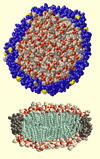Nanodiscs as a new tool to examine lipid-protein interactions
- PMID: 23404286
- PMCID: PMC4201044
- DOI: 10.1007/978-1-62703-275-9_18
Nanodiscs as a new tool to examine lipid-protein interactions
Abstract
Nanodiscs are self-assembled discoidal fragments of lipid bilayers 8-16 nm in diameter, stabilized in solution by two amphipathic helical scaffold proteins. As stable and highly soluble membrane mimetics with controlled lipid composition and ability to add affinity tags to the scaffold protein, nanodiscs represent an attractive model system for solubilization, isolation, purification, and biophysical and biochemical studies of membrane proteins. In this chapter we overview various approaches to structural and functional studies of different classes of integral membrane proteins such as ion channels, transporters, GPCR and other receptors, membrane enzymes, and blood coagulation cascade proteins which have been incorporated into nanodiscs. We outline the advantages provided by homogeneity, ability to control oligomerization state of the target protein and lipid composition of the bilayer. Special attention is paid to the opportunities afforded by nanodisc system for the detailed studies of the role of different lipid properties and protein-lipid interactions in the functional behavior of membrane proteins.
Figures


Similar articles
-
Conformational transitions in the membrane scaffold protein of phospholipid bilayer nanodiscs.Mol Cell Proteomics. 2011 Sep;10(9):M111.010876. doi: 10.1074/mcp.M111.010876. Epub 2011 Jun 29. Mol Cell Proteomics. 2011. PMID: 21715319 Free PMC article.
-
The nanodisc: a novel tool for membrane protein studies.Biol Chem. 2009 Aug;390(8):805-14. doi: 10.1515/BC.2009.091. Biol Chem. 2009. PMID: 19453280 Review.
-
Unraveling membrane protein localization and interactions in nanodiscs.FEBS Lett. 2025 Feb;599(4):512-529. doi: 10.1002/1873-3468.15059. Epub 2024 Nov 28. FEBS Lett. 2025. PMID: 39607859
-
Smaller Nanodiscs are Suitable for Studying Protein Lipid Interactions by Solution NMR.Protein J. 2015 Jun;34(3):205-11. doi: 10.1007/s10930-015-9613-2. Protein J. 2015. PMID: 25980794
-
Recent advances in nanodisc technology for membrane protein studies (2012-2017).FEBS Lett. 2017 Jul;591(14):2057-2088. doi: 10.1002/1873-3468.12706. Epub 2017 Jul 6. FEBS Lett. 2017. PMID: 28581067 Free PMC article. Review.
Cited by
-
The Convergence of Cell-Based Surface Plasmon Resonance and Biomaterials: The Future of Quantifying Bio-molecular Interactions-A Review.Ann Biomed Eng. 2020 Jul;48(7):2078-2089. doi: 10.1007/s10439-019-02429-4. Epub 2019 Dec 6. Ann Biomed Eng. 2020. PMID: 31811474 Free PMC article. Review.
-
Biofunctionalization of Multiplexed Silicon Photonic Biosensors.Biosensors (Basel). 2022 Dec 29;13(1):53. doi: 10.3390/bios13010053. Biosensors (Basel). 2022. PMID: 36671887 Free PMC article. Review.
-
Cryo-EM structures of the DCPIB-inhibited volume-regulated anion channel LRRC8A in lipid nanodiscs.Elife. 2019 Feb 18;8:e42636. doi: 10.7554/eLife.42636. Elife. 2019. PMID: 30775971 Free PMC article.
-
Protein Lipidation: Occurrence, Mechanisms, Biological Functions, and Enabling Technologies.Chem Rev. 2018 Feb 14;118(3):919-988. doi: 10.1021/acs.chemrev.6b00750. Epub 2018 Jan 2. Chem Rev. 2018. PMID: 29292991 Free PMC article.
-
Kinetic and Structural Characterization of the Effects of Membrane on the Complex of Cytochrome b 5 and Cytochrome c.Sci Rep. 2017 Aug 10;7(1):7793. doi: 10.1038/s41598-017-08130-7. Sci Rep. 2017. PMID: 28798301 Free PMC article.
References
-
- Jonas A, Kezdy KE, Wald JH. Defined apolipoprotein A-I conformations in reconstituted high density lipoprotein discs. J Biol Chem. 1989;264:4818–4824. - PubMed
-
- Wald JH, Krul ES, Jonas A. Structure of apolipoprotein A-I in three homogeneous, reconstituted high density lipoprotein particles. J Biol Chem. 1990;265:20037–20043. - PubMed
-
- Bayburt TH, Carlson JW, Sligar SG. Single molecule height measurements on a membrane protein in nanometer-scale phospholipid bilayer disks. Langmuir. 2000;16:5993–5997. - PubMed
Publication types
MeSH terms
Substances
Grants and funding
LinkOut - more resources
Full Text Sources
Other Literature Sources
Research Materials

